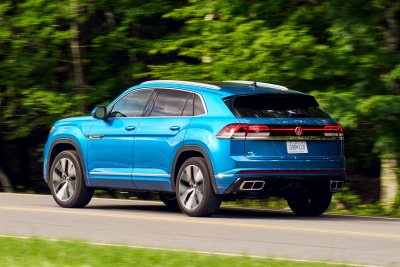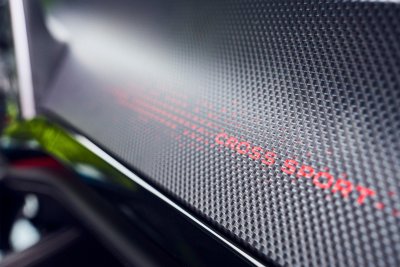In today’s American market an automaker needs at least three SUVs: a small, a medium and a large. Volkswagen had the small and medium segments covered for more than a decade, but it wasn’t until 2017 that it filled out its lineup and began selling the three-row Atlas SUV.
In 2021 the Atlas was refreshed, and gained a sibling in the form of the Atlas Cross Sport. It mirrors the Atlas except for the final third where the rear end is cut short and the roof is raked in an angle towards the back. It improves the look but does necessitate the removal of the third row, making the Cross Sport a five-passenger vehicle.
For 2024 it was refreshed again with new wraparound daytime running lights, an illuminated lightbar and illuminated VW logo, a look that borrowed from Volkswagen’s electric ID vehicles. It has a new bumper with integrated air intakes and gloss-black grille details.
It has a lower roof than the three-row Atlas and is slightly shorter and lower to the ground. All Atlas Cross Sport models feature full LED exterior lighting, including low beams, high beams, Daytime Running Lights (DRLs), side marker lights, and taillights. In the front adaptive lighting follows the curve of the road.
Volkswagen of America

Volkswagen of America
Roof rails are standard while a 4.5- by 3-foot panoramic sunroof is optional. And for 2024 Cross Sport models come with a more aggressive rear diffuser than the previous generation. In this Cross Sport, two-row form, the Atlas is one of the better-looking SUVs on the market.
Also for 2024, the Atlas Cross Sport ditched the V6/four-cylinder choice for a single option: a turbocharged 2.0-liter four-cylinder now delivering 269 horsepower (hp) and 273 pound-feet (lb-ft) of torque, an increase of 34 horsepower and 15 lb-ft offering similar horsepower and more torque than previous six-cylinder models.
Volkswagen retuned the acoustics of the engine and added more sound insulation but it’s surprisingly loud in the vehicle. VW uses what it calls the Soundaktor, which uses a speaker to send engine noise into the otherwise quiet cabin. It sounds aggressive and futuristic, in a good way, but it may get annoying over years of use. Road noise and wind noise is minimized, making that turbo/intake/engine sound even more noticeable.
The eight-speed automatic is well tuned to this engine and all-wheel drive is included in the Atlas Cross Sport SEL Premium R-Line ($53,190) tested here. Powering all four wheels does reduce fuel mileage to 19 miles per gallon in the city and 26 highway. The front drive Atlas comes in at 20 in the city and 27 on the highway. It can tow 5,000 pounds when properly equipped.

Volkswagen of America

Volkswagen of America
The turbocharged four is more than powerful enough to get the Cross Sport through traffic. These power numbers are close to V8 levels from just a decade ago. The brake pedal is stiff and grabs quickly, but is progressive after that initial bite making for confident stops from any speed.
It’s quiet over potholes as well and has more confident handling than the average two-row SUV, though it’s certainly not as rugged as something from Jeep. It will however move just as surely off road as anything not from those off-road specialists.
The cabin is excellent and styled well, the seats are a little stiff, as usual with a Volkswagen. The ambient lights look great and change the color of the Atlas Cross Sport script on the dashboard, among other places. With only two rows they’re both spacious for kids and adults and the seatbelts were easy for those in booster seats. The cargo area fit three suitcases, two of which were extra-large, along with a large and a couple of extra duffel bags.
Leatherette seats come standard with heat and ventilation and 10-way power adjustments. Both rows have integrated cup holders and SEL models get full leather trim and diamond-stitched seats. All models now come standard with two-zone climate control, heated steering and voice controls.

Volkswagen of America
It all works well, until the infotainment system, which takes more time to get used to than we had in a week of testing. The 12-inch touchscreen display features wireless Apple CarPlay but is maddening to use. It takes too long to switch between satellite channels and finding a usable display from the many options is annoying. Apple CarPlay initialized the first time but wouldn’t connect later.
The volume slider is hard to find and use during the day and impossible at night. They don’t light up so the strip under the screen just looks black. Thankfully there are controls on the steering wheel that are illuminated. The dedicated climate, assist and drive mode buttons under the screen are appreciated.
The Volkswagen Digital Cockpit is a 10.25-inch fully configurable display with four views including navigation, driver assistance features and more. There are two stereo options, the best of which being a 400-watt, 12-speaker system including a center speaker, tweeters and woofers in each door, two effects speakers in the D-pillars, a center speaker in the dash and a subwoofer in the rear.
Safety features include post-collision braking that holds the brakes after a crash to help impede a second impact. VW’s IQ.Drive system is standard on all trims for 2024 and uses radars, cameras and sensors to enable forward collision warning and automatic emergency braking, blind spot monitor, adaptive cruise control. It also enables Travel Assist, a semi-automated hands-on driving capability that works from 0 to 95 mph. The tech keeps the vehicle in the lane and controls braking and accelerating while the driver uses minimal force on the wheel. The driver is required to keep their hands on the wheel and eyes on the road.
The Atlas Cross Sport also comes standard with parking sensors and exit warning, which warns a passenger if they’re about to open a door into an oncoming vehicle.
All of that safety technology works in the background and was never intrusive over the several hundred miles we drove over the week. The IQ.DRIVE system is better than some because it uses capacitive touch on the steering wheel meaning it can sense the driver’s hand. Some systems need the driver to move the wheel every few seconds.
The VW Atlas Cross, with a base price of $36,985, battles for sales with other two-row SUVs like the Subaru Ascent ($34,395), Honda Pilot ($37,090) and Jeep Grand Cherokee ($40.035). Against those competitors the Atlas is probably the least rugged, but with 4Motion four-wheel drive it won’t leave you stuck anywhere but the muddiest, rockiest trails.
The Grand Cherokee has more luxury appointments and more four-wheel drive capability, but the other two and the Chevrolet Traverse ($34,520) are good options too.
Volkswagen can count the new Atlas’s stylish and futuristic looks as a win, something the rest of the group is lacking. But, potential buyers should definitely take a test drive of the infotainment before purchasing.
Uncommon Knowledge
Newsweek is committed to challenging conventional wisdom and finding connections in the search for common ground.
Newsweek is committed to challenging conventional wisdom and finding connections in the search for common ground.


